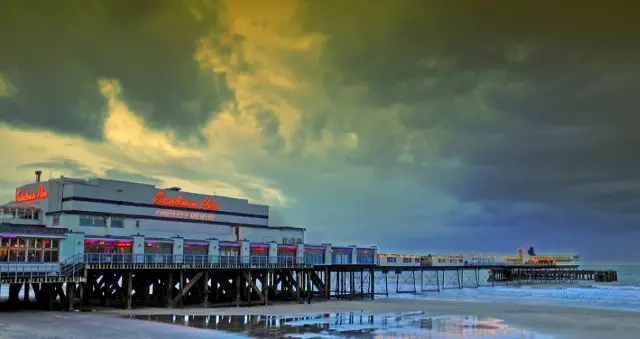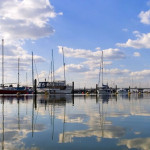Our thanks to guest writer, Steve Blamire, for sharing this opinion article with OnTheWight readers. In his own words. Ed
The recent refusal by planners to allow developers to proceed with the demolition of The Grand Hotel is the right decision, for the moment. However it leaves me divided.
Sandown desperately needs investment, on a massive scale. The Grand in its current state with its brutal façade and years of neglect is a classic example. Redevelopment along with other prime sites such as the White City and The Savoy Hotel hold the potential to unlock the wider regeneration of the town’s fortunes.
What kind of redevelopment?
Where the divide appears is in the form that redevelopment takes. The Grand, let’s face it, has not been very grand since the early post-war years and from the early 1970s began to suffer from unsympathetic architectural modifications. However it remains one of only a handful of art deco buildings on the Island, the majority of which are under threat from the ravages of time and neglect.
The proposed development scheme, which could be loosely described as a ‘box with balconies’, is devoid of any serious architectural value and would do little in terms of projecting the town’s ambitions for the future. However it would provide much needed improved accommodation stock in the area.
Lacking a sense of place
There is also a wider cultural value attached to The Grand and other prominent sites in the town, the role they play in creating what geographers refer to as ‘a sense of place’. Through many years spent wandering the streets of Sandown one thing that has always struck me is the lack of a deeper sense of place.
By a sense of place I don’t just mean the physical features, it is a combination of characteristics that make a place special and unique – its beginnings, its history, its human influence, its local knowledge, its folklore, its memories, its story.
Travel along the coast to Shanklin and Ventnor and that sense of place is much more immediate – the direct connection with the sea; fishing, smuggling, the Victorian’s arrival, grand villas and hotels, formal gardens and parks, the arcades and kiss-me-quick remnants of 20th century tourism through to the modern day additions. Even the Victorian ‘Old’ Village at the heart of Shanklin, however pastiche, plays an important role.
It’s there, but hard to find
In Sandown you have to work hard to find it, yes there is the stunning beach, the Esplanade, the pier, a conversation with Ken Kemp if you are lucky, but what connects those to a wider sense of place seems to have been lost along the way. What remains on the odd street corner or tucked away in back and side streets feels under threat from those very same forces, ever present in post-war Sandown, and ever present today.
I am not writing this from a nostalgic ‘maintain the past at any price’ point of view, the future is as important as the past in developing that sense of place. Buildings and structures become redundant, tastes change and time moves on, but that process needs to be managed in a way as to be sensitive to the past, relevant to the present and defining of the future.
In regard to The Grand there are potential schemes to achieve just that; it could be completely restored, albeit with less rooms; it could receive a clever façadist treatment that included the ground floor and key features or it could even be demolished and replaced with something Gehry-Foster-Hadid-esque that pointed towards a new future for Sandown, but please, please, not a ‘box with balconies’. It adds little or nothing to the story.
Innovation is welcome
A great current example is Bruce Webb’s innovative project to save the Rivoli. The art deco cinema which opened in the 1920s, one of the first in the UK, is due for demolition in early 2014. Bruce has set up a crowd-funding project to raise funds to restore it as a cinema and base for the developing Isle of Wight Film Festival. If successful it will be a great model of that blend of past, present and future and a great new cultural asset, bringing new people, ideas and energy to the town.
There is a willingness to invest, political and public support for progress, people with passion and the availability of key sites within the town, all the ingredients needed to kick-start regeneration. It is now over to the developers to utilise the opportunity and deliver schemes that go beyond the lowest common denominator, making a connection with a sense of place whilst defining a Sandown of the future.





